About Food
About food
We’re familiar with the words ‘nutrition’ and ‘energy’ concerning the foods we buy. It’s almost all we hear when we’re bombarded with adverts on the way to the shops, and have an endless selection to choose from. On a bushwalk, we’re limited by how much space we have in our backpacks, how much weight we can carry and how well the food travels away from a fridge and being tossed around in a backpack. For short trips, we can get away with some heavy foods, but on longer trips meals have to be lighter.
While a balanced diet consisting of fresh fruits and vegetables is important on a day-to-day basis, the primary concern when packing food for a multi-day hiking trip is energy. The aim is to maximise the energy contained in food while minimising the weight, as weight is generally the limiting factor on extended bushwalking trips.
It’s also important to select foods that you find are easy to eat, digest and enjoy while being active in the bush. Everyone is different, and a diet that works well for one person is wrong for another. It’s a great idea to test out some foods at home before taking them bushwalking. That way you can test out quantities and double-check that your stomach agrees with the food!
Last but not least, remember that the value of food goes beyond nutrition: it provides a connection and is a wonderful social element too. It’s a nice feeling to be able to sit down and share a meal with others and get to know them a little better in the process.
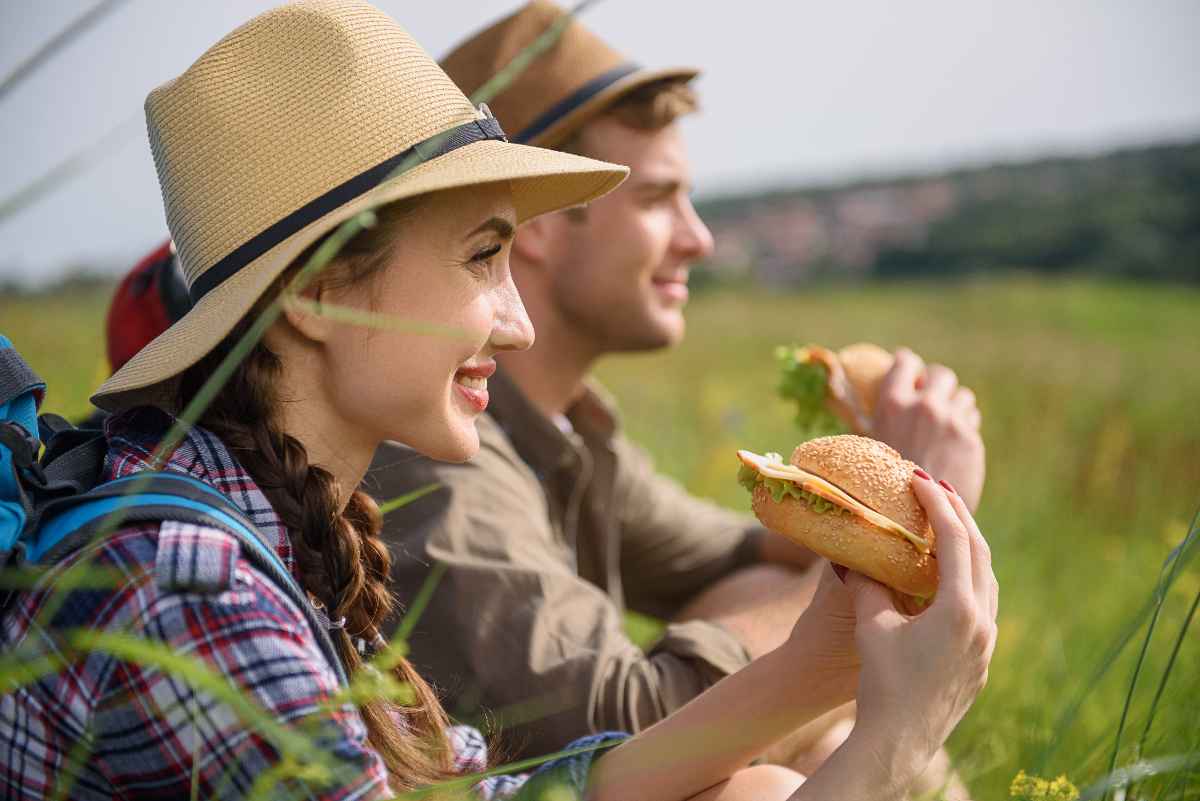
Energy
The energy stored in food is measured in kilojoules (kJ), or calories (Cal), and these typically expressed on the packaging in terms of energy per serving, and per 100g. One Calorie is equal to 4.184 kJ, and although both units are commonly used on packaging, the kilojoule (kJ) is the SI unit of food energy in a nutritional context.
The term ‘calories’ is slightly confusing. The small calorie (‘cal’) is the quantity of energy needed at a pressure of one atmosphere to raise the temperature of one gram of water by one degree Celsius. The large calorie (‘Cal’) is the quantity of energy needed under the same conditions with one kilogram of water, so one ‘Cal’ is 1000 calories. The large calorie (‘Cal’) is also known as the ‘food calorie’ and is the one listed on the back of food packaging.
Nutritional information typically looks something like this:
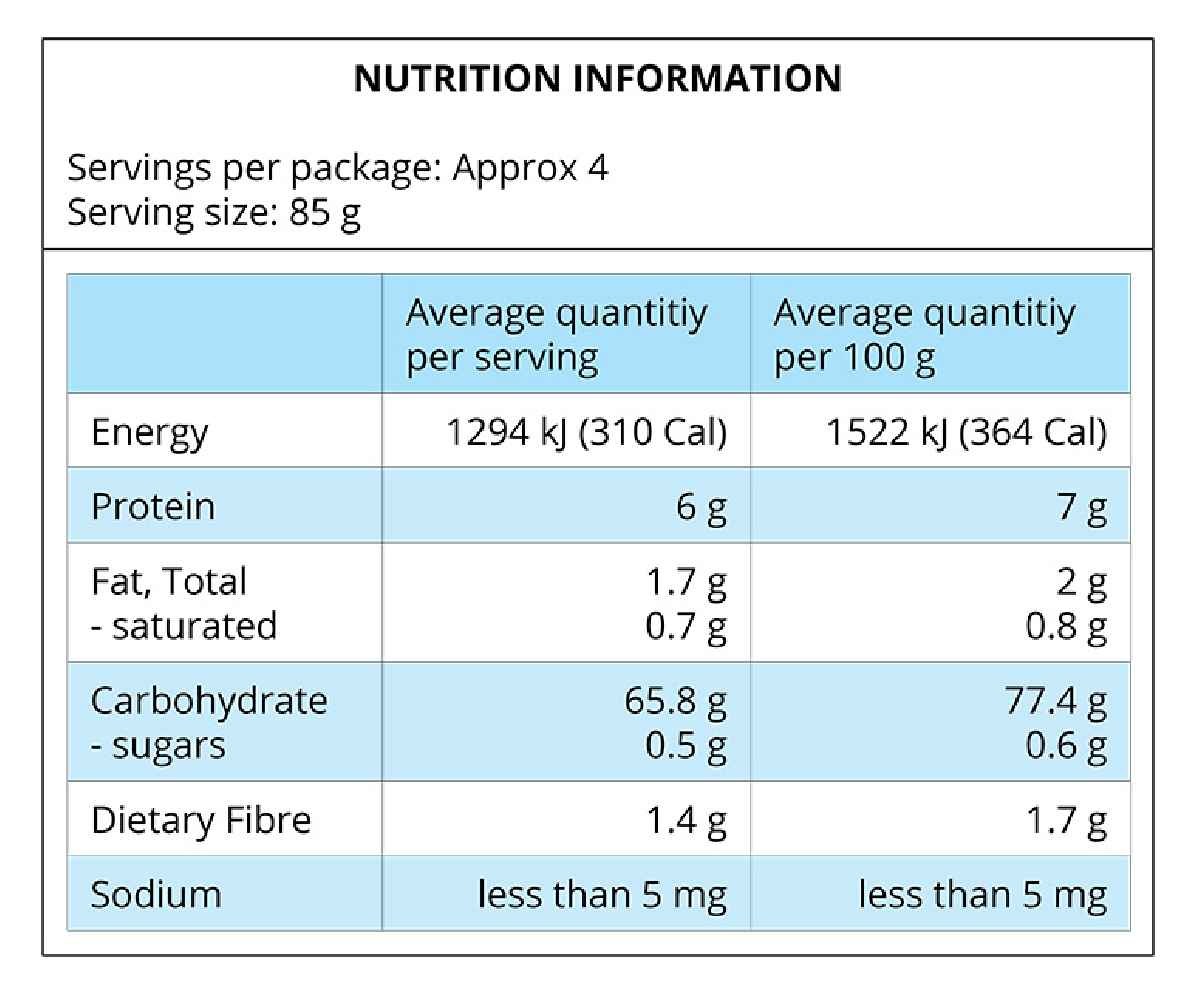
It contains information about the total energy, as well as how much fat, protein, sugars and so on it contains. Nutritional information is typically further broken down into serving categories for ease of use by the reader:
Servings per packet: this tells you how many servings are contained in the entire box/bag/can/jar/package that the food came in, and helps you to calculate how if the amount of food contained is sufficient.
Serving size: this tells you the typical size of a serving per person. Beware that many serving sizes are typically smaller than what a hungry bushwalker wants to eat! Test out serving sizes at home before committing to a long trip.
Average quantity per serving and Average quantity per 100g: these are the breakdown of various nutritional components (energy, protein, fat etc), so you can get a sense of what nutritional components the food comprises of. Broken down per serving gives a good sense of what you get per serve, whereas the average per 100g allows you to compare between food types using a standard quantity.
For example, using the nutritional information standardised per 100g, you can get a sense of how the energy density varies between high-density foods (e.g. biscuits), compared to foods with high water content (e.g. apples).
The following table gives an easy visual representation of how their energy and nutritional contents differ:
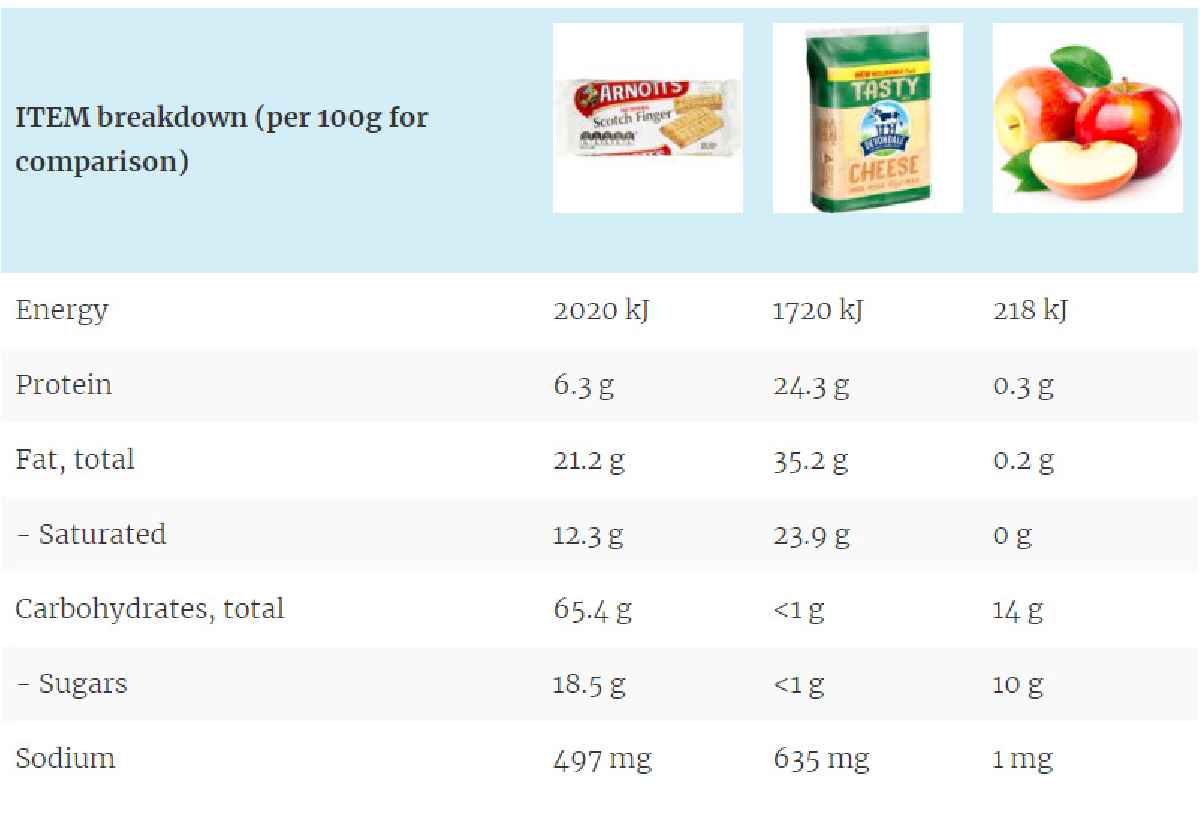
Biscuits are a ‘high-energy’ food for their weight, compared to fruit: biscuits have around 10 times the amount of energy compared to their equivalent weight in apples. In day-to-day life, we generally try to limit energy-dense foods, preferencing a mixed diet with plenty of nutrition. However, on a bushwalking trip, we tend to prefer foods with higher carbohydrate and fat content than normal to get the most energy per gram of food weight we’re carrying. This is not an excuse to get carried away: you should still aim to eat a balanced and healthy diet, be mindful of your increased energy needs.
Energy density is calculated as follows: energy density = no of calories/weight.

Energy-dense foods tend to be high in fat and carbohydrates and have low water content (the energy density of water is zero). These are foods like biscuits, chips and cheese. Low energy foods such as fruit and vegetables tend to have high water content. For a bushwalking trip, it makes sense to prioritise energy-dense foods over foods with high water content, especially for multi-day trips where weight becomes a concern. On walks longer than a few days you will need to start considering nutrition more broadly then energy, including foods like dehydrated fruits and vegetables to ensure you are getting all your key nutrients.
Energy intake for bushwalking
The average energy intake for adults is 8700 kJ, however, the exact energy requirements of any given individual varies with body size, age, activity, gender, metabolic rate, fitness etc.
Below is a table adapted from Xtreme Gourmet High-energy, lightweight recipes for the outdoor enthusiast by Sonya Muhlsimmer.
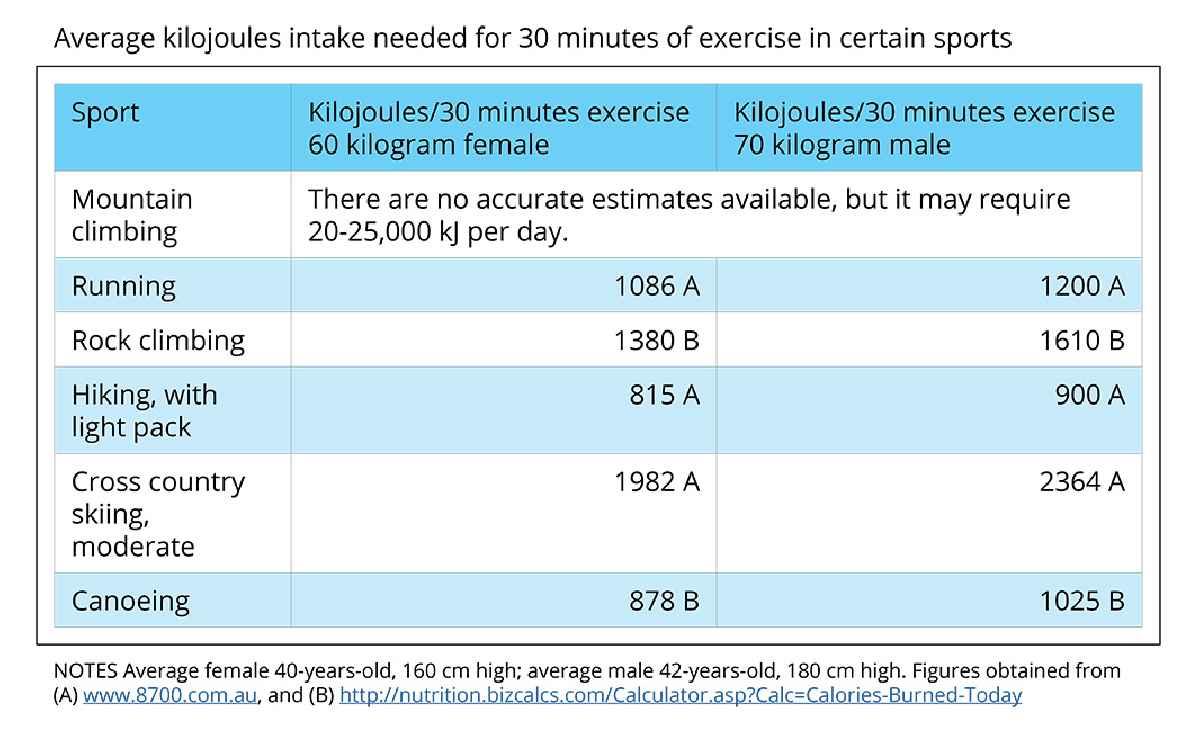
Technically speaking, you could carry enough rice to gain all your energy requirements on a multi-day bushwalking trip. However, carrying a variety of foods not only ensures that you meet your additional nutritional requirements, but it also gives you options to eat what your body feels it can digest at the time, as well as ensuring a good appeal and appetite for food. Sure, you’ll survive, but your body won’t be operating optimally under these conditions.
Nutrition
After eating, we use food to fuel, build and repair our bodies. Carbohydrates give us the energy that keeps us moving. Protein builds, maintains and repairs tissues. Fat provides energy, maintains core body temperature, and is critical for normal brain development and nerve function. Fat also helps with making hormones and transporting and absorbing fat-soluble vitamins, such as vitamins A, D, E, and K.
Vitamins and minerals are essential nutrients in day-to-day life because, amongst other things, they bolster our immune system, helping us battle infections. They are also important in strengthening bones and muscles.
As a general rule, carbohydrate-rich foods are good sources of energy before and during exercise, and protein-rich foods are great for repair and recovery afterwards (at the end of the day). It’s also important to snack regularly to keep up energy levels.
Water is also essential for staying hydrated and feeling great on a bushwalk.
CARBOHYDRATES
Carbohydrates are biomolecules found in food and can provide energy when consumed. Carbohydrates come in two forms – simple or complex – and both have different properties in terms of how they release energy to the body.
Simple carbohydrates are foods high in glucose sugar like lollies and honey. They are short-term energy resources that the body can use immediately.
By contrast, complex carbohydrates release energy slowly. Fibre and starch are complex carbohydrates found in foods like bread, pasta and rice. Fibre also keeps our digestive systems regular and healthy. Fibre is the indigestible (by humans) part of plant foods found in fruit and vegetables, beans and legumes. However, on an extended bushwalking trip, it isn’t practical to carry large amounts of fresh fruit and vegetables. Instead dietary fibre can be found in other foods, for instance, oats for breakfast, wholemeal pasta for dinner.
Research studies have found that consuming carbohydrates before an event can improve performance up to 6%. Before a harder or multi-day bushwalk consider eating 8-10 g/kg body weight of carbohydrates in the days leading up to the bushwalk.
During the bushwalk, keep energy levels up by carrying food and water and stopping regularly to refuel. Research suggests consuming (eating or drinking) 30-60g carbohydrates per hour during an endurance event is optimal. So healthy snacking on the track can be a good thing.
Below is a table adapted from Xtreme Gourmet High-energy, lightweight recipes for the outdoor enthusiast by Sonya Muhlsimmer.
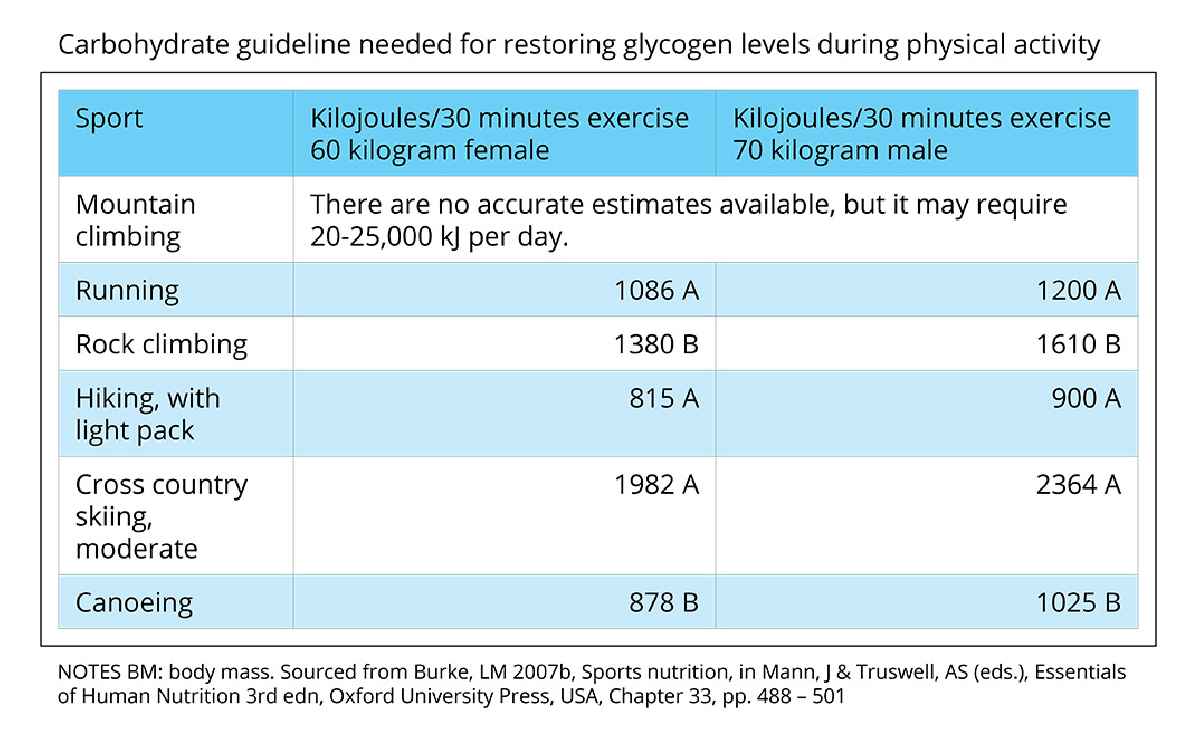
Some lightweight high-fibre foods include:
- Beans and pulses. Carry dried beans or pulses such as chickpeas and lentils. To save cooking time, partially rehydrate the amount you need for dinner during the day in a small amount of water (and old peanut butter jar works well).
- Wholegrain and wholemeal pasta are excellent sources of fibre but takes longer to cook. Consider thinner pasta options for faster cooking.
- Brown or wholegrain rice. Also takes longer to cook than white rice. Consider soaking rice during the day to speed up cooking.
- Nuts. Almonds, pecans, and walnuts have more fibre than other nuts.
- Dried fruit. If fresh fruit isn’t available, dried fruit offers a fibre-full snack. A 50g portion of dried figs is 4g fibre.
- Porridge and bran based cereal are high in fibre and lightweight.
FAT
Fats are biomolecules found in foods and are made up of components known as ‘fatty acids’. They are an extremely concentrated form of energy (37 kJ/g), which is roughly twice that of carbohydrates and proteins.
Food rich in fat include meats such as fatty pork, lamb, beef and chicken (particularly with skin), oily Fish (Salmon, mackerel, trout, tuna) and also small fish such as sardines, herring and anchovies, nuts, seeds and grains (cashews, almonds, walnuts, sunflower seeds), dairy foods (butter, cream, full fat milk and cheese) and some fruits (avocados and olives).
There are four different types of fats (saturated, monounsaturated, polyunsaturated and trans) and our bodies deal with them all slightly differently. Polyunsaturated and monounsaturated fats are generally healthier options to saturated and trans fats.
Saturated fats tend to raise LDL (Low-Density Lipoproteins) cholesterol levels. LDL cholesterol is considered ‘bad’ cholesterol because it contributes to the narrowing of the arteries, which can lead to cardiovascular diseases (such as heart disease and stroke). Foods high in saturated fats include butter, lard, full-fat milk, cheese, coconut & Palm oil, fat-cut meat, poultry (with skin).
Trans fats also tend to raise LDL blood cholesterol and lower HDL cholesterol. HDL cholesterol is ‘good’ because it carries cholesterol from the blood back to the liver, where it is broken down, reducing the risk of cardiovascular disease. Trans fats are even more damaging than saturated fats because of the lowering of HDL cholesterol. Examples include hydrogenated oil (found in processed foods e.g. cakes, pies etc).
Polyunsaturated and monounsaturated fats help to decrease the bad (LDL) cholesterol and increase the good (HDL) cholesterol. Polyunsaturated fats have a slightly greater impact than monounsaturated fats.
Examples of bushwalking foods that are high in polyunsaturated fats include:
- Brazil nuts/walnuts
- Linseed (flaxseed)
- Chia seeds
Examples of monounsaturated fats include:
- Almond/canola/olive oil
- Avocado
- Peanuts
- Hazelnuts
- Cashews & almonds
Protein
Proteins are made up of amino acid chains and large biomolecules. We need protein for growth and repair of muscles, and our protein requirements go up with the more activity we do as indicated by this table. Men generally need higher levels of protein intake than females.
Below is a table adapted from Xtreme Gourmet High-energy, lightweight recipes for the outdoor enthusiast by Sonya Muhlsimmer.
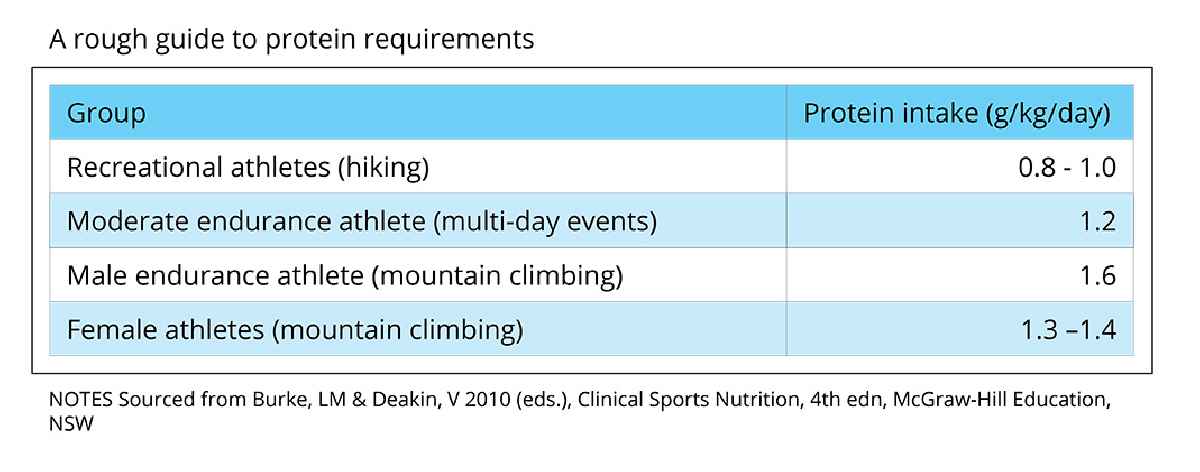
High protein foods are lean meat, poultry, fish, eggs, tofu, nuts, seeds and legumes/beans. Both animal and plant sources of proteins contain different essential amino acids, so it is important to eat a variety of protein foods to acquire an adequate mix of amino acids.
Great bushwalking foods high in protein include:
- Fish – tins or sachets (e.g. Safcol Salmon sachet)
- Mixed nuts
- Long life tofu (e.g. bonsoy-firm-silken-tofu)
- Chicken – tins (e.g. Heinz)
Vitamins, minerals and electrolytes
Vitamins and minerals are naturally occurring chemical compounds found in foods and are vital for a range of cellular processes. They are required in small quantities in the diet because our bodies cannot synthesise them naturally.
The best sources of vitamins and minerals are healthy unprocessed foods. For instance:
- Vitamin A is essential for eye health and immunity against infections, and can be obtained from eating oily fish (salmon, sardines, herring), full cream dairy products, butter and table margarine, egg yolk, and bright coloured fruits and vegetables (carrots, spinach, apricots, mango, pumpkin, broccoli).
- Vitamins B (e.g. B1, B2, B3,B6, B12) help release energy from food, and are important for the nervous system and digestive health, amongst other functions. Vitamins B are found in fish, meat, eggs and dairy products, leafy green vegetables, beans and peas.
- Vitamin C is important for keeping skin, bones and connective tissue healthy, helping wounds heal and preventing infections, as well as helping absorb iron from food. Vitamin C can be found in many fruits and vegetables: berries, citrus fruits, kiwis tomatoes, broccoli, sprouts.
- Calcium, a mineral that is essential for building strong bones, muscle and nerve function and blood clotting, is found in milk, cheese, yogurt, canned sardines, salmon, Asian green vegetables and tofu. Calcium works together with vitamin D to make healthy strong bones and teeth.
Electrolytes are a specific kind of mineral with an electric charge that allows cells to function and communicate. Electrolytes are lost through sweat, so when we work hard, we must replenish our body’s electrolyte supplies by eating. For example, too little of the electrolyte potassium can lead to cramps. Bananas are a excellent source of energy and are also high in potassium, which is why you often see tennis players eating bananas between games.
Since electrolytes are lost via sweat, as bushwalkers, we must be particularly conscious of replenishing electrolyte supplies on hot days and when bushwalking across harder terrain.
Physical properties
Type unknown ():
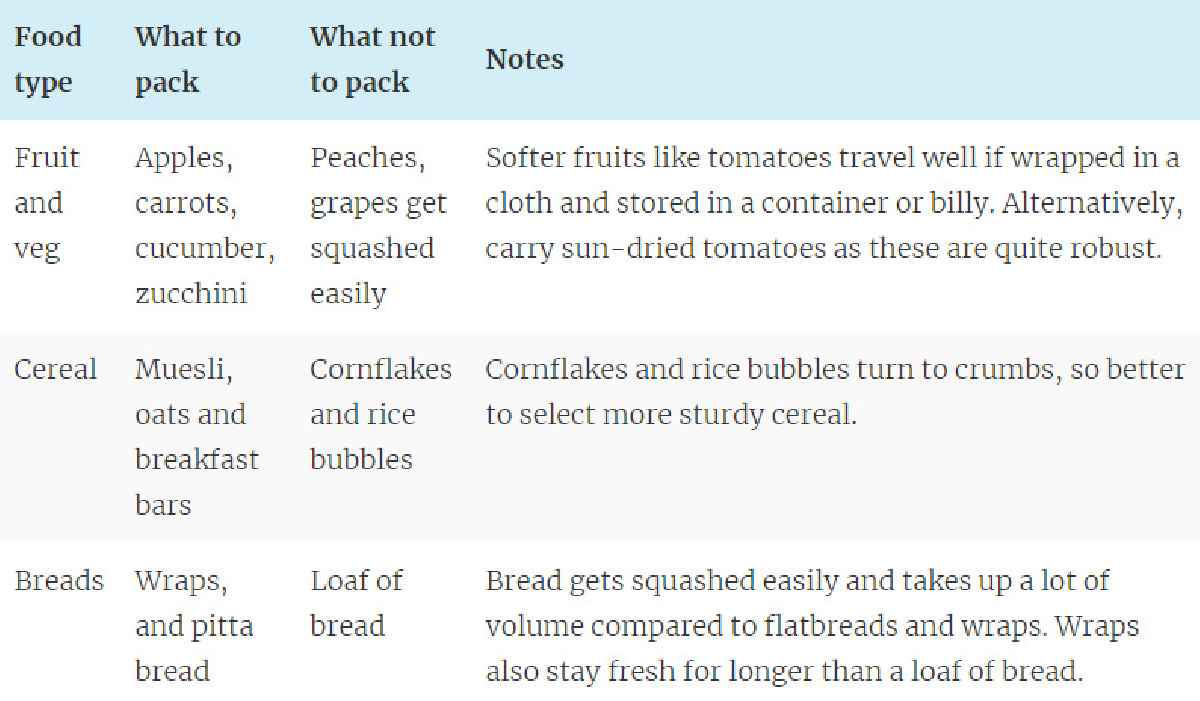
LONGEVITY
Food longevity is a consideration on a bushwalk because it’s hard to keep food chilled. Some foods can last for months in a backpack without any trouble (e.g pasta), whereas others go off very quickly (e.g. meat), particularly in hot, humid conditions.
Generally, foods with high water content, such lettuce and cucumber, don’t last long, as well as animal produce (e.g. meat) and dairy (e.g. cheese).
On extended trips, where you need to carry all your meals, consider using dried and long-life alternatives.
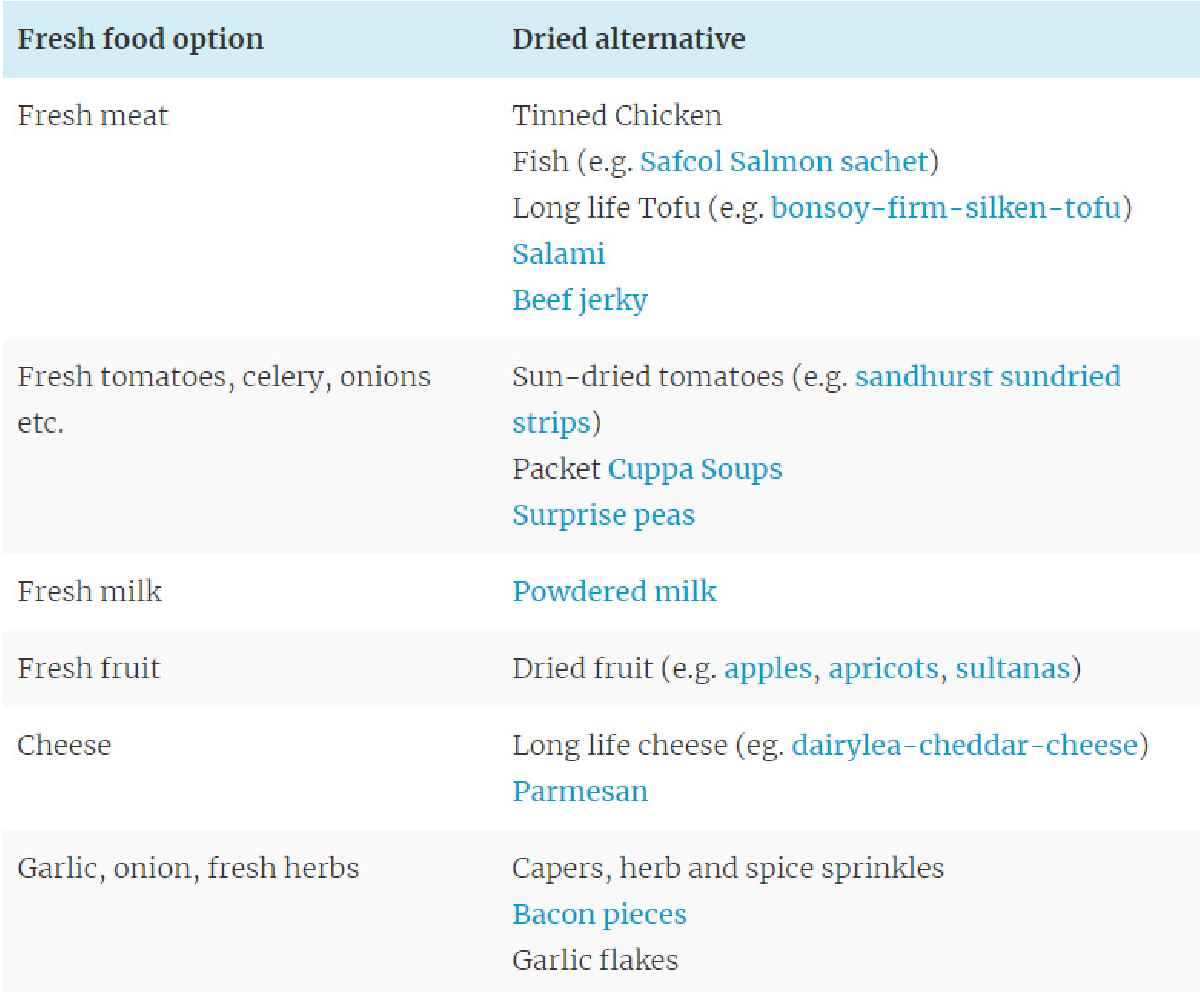
COST
So far, we’ve talked a lot about dried food, which may seem quite specialised, however, the reality is that you can get plenty of great bushwalking foods at your local supermarket.
Specialised dried hiking meals (e.g. Backcountry Cuisine) sold in camping stores look appealing for their ease of preparation, but tend to be expensive and often cost-prohibitive to many bushwalkers, especially on longer walks.
Most local supermarkets tend to stock all the ingredients that you need to prepare lightweight foods. It’s just a matter of looking in a different aisle a lot of the time. Asian supermarkets also have a great variety of long-life and lightweight foods.
PACKAGING
We already touched on packaging in the weight category above, but we’ll go through it again here just to reiterate the point that you want to reduce your overall weight and volume of food you carry by minimising packaging.
Tins were once common for people going bushwalking, but plastic packaging is by far the most prevalent now. Tinned food such as tuna, sardine, salmon, baked beans, creamed corn etc. are convenient and make sure that foods carry well and last. Choose tins with a pull ring opener, so there is no need to pack a can opener (unless your penknife already has a can. The downside of tins and cans is that they are relatively heavy and you have to carry the empty tin weight back home. These days if bushwalkers are to carry these heavier foods they tend to use the plastic packaging, rather then tins.
Carry as little packaging as possible on the trip by spending a little bit of time repacking your food before heading off. For example, pack just enough coffee for the trip, not the whole jar. Take only enough muesli for the breakfasts you need.
Resealable plastic bags are great for carrying small amounts of food like hot chocolate, tea, coffee, sugar and milk powder. Small food-safe containers are great for taking small amounts of butter, oil, salt and pepper.
Leave no trace by carrying all your rubbish out – all leftover food, paper and plastic packaging, cans, fruit peels and cores. Back home, recycle what you can.
Social
The value of food goes beyond nutrition: it also provides a unique opportunity for social connection.
At the end of a long bushwalk, there’s nothing nicer than gathering around and sharing a meal with friends. Food also plays an important part in boosting not only energy but also the group’s morale, particularly hard trips.
Here are some foods are easy to share on a bushwalk:
- Scrogan or trail mix
- Chocolate
- Cheese platter – biscuits, olives, cheese
- Jaffles – everyone loves a bite of a melted cheese and tomato jaffle!
- Popcorn, chips and dip
- Curry and rice dishes
- Hot chocolates, soup, tea, or a port after dinner
- Sushi rolls – it is possible and yummy
